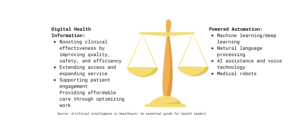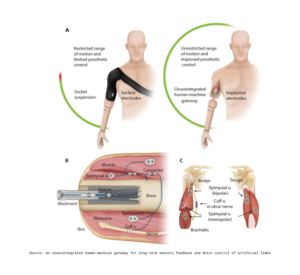- Industries
Industries
- Functions
Functions
- Insights
Insights
- Careers
Careers
- About Us
- Healthcare
- By Omega Team

Some people are born with limb loss (congenital limb deficiency), while others may lose limbs due to infections, trauma, cancer, or complications that arise in blood vessels. The nonprofit Amputee Coalition estimates about 2 million amputees in the U.S., and that number is expected to nearly double to 3.6 million by 2050. Vascular disease, including diabetes and peripheral artery disease, accounts for 54% of all amputations in the U.S. Other major causes are trauma (45%) and cancer (less than 2%). Amputation presents both physical and emotional challenges. The loss of a leg or arm can impact a person’s ability to walk or balance correctly. Even the simplest daily tasks can turn into a challenge for them. An amputation is a traumatic experience, causing the victim to relive the memories that caused the accident. Around 30% of people with limb loss experience depression and/or anxiety. Many individuals also suffer from issues regarding body image and how others perceive them.
Implanting an artificial limb that replaces a missing body part can be an optimal choice for amputees. Its goal is to replace as much function of the original limb as possible. At the very least, a prosthetic should help an amputee take care of necessary daily activities such as eating, walking, and getting dressed on their own.
Function of Bionic Arms
Basic artificial limbs have been used since 600 B.C. They provide very little or no functionality and are simply worn to give a natural appearance of a limb. Traditional upper-limb prostheses use cables and harnesses attached to the individual and rely on body movements to manipulate cables that control the prosthetic limb. This can be physically tiring, cumbersome and unnatural. Functional prosthetics are typically available in both body-powered and electrically powered forms, with the electrically powered option relying on batteries and motors to power movements. This type of prosthetic will react based on detected muscle movements in the residual limb or upper body.
The term ‘bionics’ was first used in the 1960s. It combines the prefix ‘bio’—meaning life—with the ‘nics’ of electronics. Bionics is the study of mechanical systems that function as living organisms or parts of living organisms. A bionic limb gives the user much more control and movement through the use of sensors and computers that respond to both thoughts and muscle movement. This functionality takes much of the workload off of the user’s body and acts more similar to a real limb. Ultimately, bionic limbs provide much more ease and functionality when compared to traditional prosthetic limbs and require less effort from the user.
AI Technologies applied to Bionic Arms
Artificial intelligence (AI) is evolving rapidly in healthcare. The AI technologies can be used as powerful tools and partners to enhance, extend, and expand human capabilities, delivering the types of care patients need, at the time and place they need them. Humans and AI can form a partnership to improve clinical effectiveness (ie, quality, safety, and efficiency), access, and affordability of care. Medical robots equipped with AI technology can help with surgical operations, rehabilitation, social interaction, assisted living, and more.
Figure 1: Human-machine Partnership in Healthcare

Fast-moving research of improving bionic limbs is being conducted to improve people’s lives by restoring both movement and feeling. In 2020, thanks to a new implant system, patients with mind-controlled arm prosthesis were able to experience a sensation of a touch. This news was encouraging, but we still have a limited understanding of how our brain manages to do movements exactly. Processing the amount of data running between our brain and limbs will require more advanced algorithms as the technology advances. To fill this gap, attempts are being made to incorporate AI technology into bionic arms. For now, the AI-enabled artificial limb remains in the testing stage, but the ultimate goal is to produce a refined prosthetic that amputees can wear in their daily lives.
Manufacturing Process
Several bionic arms are now available which are beginning to mimic some of the functionality of the original lost limbs. Others are still at the research and development stage but are showing great promise. The following is a brief introduction and manufacturing process for several different types of prosthetic arms.
External Prosthetic Limbs
Myoelectric limbs: Myoelectric limbs use a battery and electronic system to control movements. Each prosthesis is custom made, attaching to the residual limb using suction technology. Once the device has been securely attached, it uses electronic sensors to detect even the smallest traces of muscle, nerve, and electrical activity in the remaining limb. This muscle activity is transmitted to the surface of the skin where it is amplified and sent to microprocessors, which use the information to control the movements of the artificial limb. Based on the mental and physical stimulus provided by the user, the limb moves and acts as a natural appendage. By varying the intensity of the movement of their existing functional muscles the user can control aspects such as strength, speed, and grip in the bionic limb. If muscle signals cannot be used to control the prosthesis, switches with a rocker, pull-push, or touchpad can be used. Improved dexterity is achieved via the addition of sensors and motorized controls, thus enabling users to perform tasks such as using a key to open a door or getting cards out of a wallet. A bonus of the myoelectric limb is that, same as traditional body-powered devices, it can be made to replicate the appearance of a natural limb.
Osseointegration: (OI) is a process creating direct contact between living bone and the surface of a synthetic—often titanium‐based—implant. The procedure uses a skeletally integrated titanium implant, connected through an opening (stoma) in the residual limb to an external prosthetic limb.
The procedure requires two operations. The first involves the insertion of titanium implants into the bone and, often, extensive soft-tissue revision. The second stage, around six to eight weeks later, includes the refinement of the stoma and the attachment of the hardware that connects the implant to the external prosthetic limb. Gradually, bone and muscle begin to grow around the implanted titanium on the bone end, creating a functional bionic limb. The external prosthesis can be easily attached and removed from the abutment within a few seconds. Continuing development in the field of OI is the introduction of products that use a porous metal construction, such as titanium foam. Traditional OI designs intended for the femur were not successful when applied to the tibia as the proximal tibial bone structure is highly spongy. However, with the development of titanium foam technology the application of OI has now been expanded to amputees.
Figure 2: Body Analysis of Prosthetic Control

Mind-controlled bionic limbs: These are prostheses that can be integrated with body tissues, including the nervous system. They are highly advanced, able to respond to commands from the central nervous system and therefore to more closely replicate normal movement and functionality, while also instantly triggering the desired movement with less ‘lag time’. There are several different procedures and technologies currently in the research and development phase.
Targeted muscle reinnervation: A surgery called targeted muscle reinnervation uses nerves remaining after an amputation, and the same impulses from the brain that once controlled flesh and blood, to control an artificial limb. The surgery reattaches nerves that control the joints from the missing part of the limb into muscle tissue in the residual limb to allow a more natural thought process and control the prosthesis the same way as myoelectric control. Effectively, the brain impulses are linked to a computer in the prosthesis that directs motors to move the limb. The procedure involved numerous steps over many months.
Drawbacks
Many functional and imitative bionic arms are expensive, and they have certain requirements about the recipient’s physical condition, so that it is not easy for amputees to tailor a suitable bionic arm to themselves. Occurrence and severity of adverse events with bone-anchored bionic prostheses are yet to be fully resolved. Bionic limbs can potentially cause issues with implant stability, bone fracture, breakage of the implant parts and infection. All these adverse events have several common negative effects, for instance, pain and disruption to lifestyle because of the limitation to the usage of the prosthesis for prolonged duration.
Battery and motor inside the myoelectric arm makes it heavy, it is expensive, and there is a slight time delay between the user sending a command and the computer processing that command and turning it into action. A disadvantage of OI arms is that the area where the implant enters the skin (called the “stoma”) has to be cleaned twice daily with soap and water. This is comparable with brushing teeth. In some cases, the skin around the stoma may become irritated. OI is an advanced technology that the recipients of it report that it feels close to a real limb, but it can be costly (generally over $80,000) and unsuitable for many types of amputee.
Overuse syndrome is a common problem of bionic limb recipients, where additional and atypical amounts of time and pressure are borne down through the intact limb. Over time, this can and will cause early degeneration of the lower back, hip, knee and ankle resulting in discomfort and other complications. This becomes even more important if there are injuries to the intact limb, which make it even more critical that the prosthesis be designed to evenly bear the load and smooth out every step in individuals’ gait. Moreover, friction rashes are a frequent side-effect of wearing a prosthesis. When sweat disrupts close liner adherence to the skin, the sweat-soaked outer layers of the skin will easily abrade and develop a rash or blisters, as early as after a few hours. It may take days for a rash or blisters to heal, during which the prosthesis should not be worn. Sweat may also lead to disruption of myoelectric control as early as 10 min into intensive manual labors.
Future Outlook
Advances have made these artificial limbs more practical and intuitive, but even the most state‐of‐the-art prostheses cannot yet replicate the full functionality of natural limbs. There is still huge room for improvement in these technologies in the future. AI and machine learning technologies are incorporated into the new mind-controlled bionic arms. Currently, many advanced technologies are in the laboratory stage and looking for marketing transitions, and the biggest hurdle is its cost.
Worldwide, access to prosthetic care is limited. The World Health Organization estimates that 30 million people are in need of prosthetic and orthotic devices — yet more than 75 percent of developing countries do not have a prosthetics and orthotics training program in place, often leading to poorer clinical coverage of patients. Even in the U.S, only 1/4 of upper-limb amputees use prosthetics. Applying 3D printing technology to the manufacturing of bionic arms is a feasible way to solve the cost problem in the future.
Technical Development
Several different procedures and technologies of mind-controlled bionic limbs are currently in the research and development phase. Researchers from Iceland have created a mind‐controlled prosthetic leg that uses implanted myoelectric sensor (IMES) technology. With this advanced technology, they no longer need to think about their movements because their unconscious reflexes are automatically converted into myoelectric impulses that control their bionic prosthesis. Taking this a step further, in 2015 researchers at the US Defense Advanced Research Projects Agency (DARPA) announced that they had given a paralyzed man the ability to feel physical sensations via a prosthetic robotic hand that had wires directly connected to his brain.
The robotic arm being developed at Johns Hopkins APL has 26 joints and ‘load cells’ in each fingertip to detect force and the torque applied to each knuckle. Sensors give feedback on temperature and vibration and collect the data to mimic what the human arm is able to detect. Its response to thought is proximate to a normal arm. The device attaches to the user via an osseointegration implant, a small post that goes into the bone and protrudes through the skin. That orientation allows the device to clamp directly onto the skeletal system, giving the user a more natural understanding of how the limb is moving. By attaching to the bone, the perception of weight is also lower than traditional external attachments.
3D-Printing in Bionic Arms
The 3D printing design is beginning to help create bionic arms that are a perfect custom-fit for the wear at a more affordable price. Driven by a deep desire to create affordable solutions for people with disabilities, the team ‘eBionics’ of teenagers from Skopje, North Macedonia won Global Generation Unlimited Challenge 2019/20 prize by developing a 3D-printed bionic arm 30 times cheaper than existing prosthetics. Their ‘VenusArm’ was entirely 3D printed and used muscle sensors to allow for flexible movement that helped the user in everyday life. In their introductory video, a young woman is shown using the bionic arm to operate a sewing machine and even to drive a car. They also used an impression mold to create a universal socket, which means it will fit anyone, even growing children.
3D printing will make a great contribution to the manufacturing of bionic arms in the future. Prostheses can now be created with anatomically correct shapes that mirror the form of the wearer, and can incorporate details such as accurate skin colour, freckles, birthmarks, hair, veins, tattoos, fingerprints and fingernails. These life-like creations can be made from PVC or a range of silicones and cover the prosthetic limb using a variety of methods, such as adhesive, stretchable skins, suction, form fitting, or a skin sleeve. In the future, bionic limbs will become more and more common to provide high-quality and inexpensive services for the individuals in need.
Subscribe
Select topics and stay current with our latest insights
- Functions